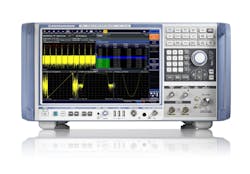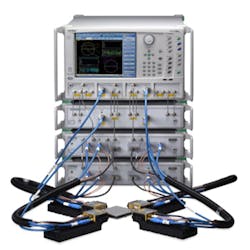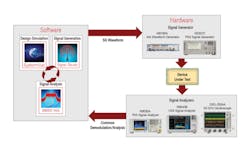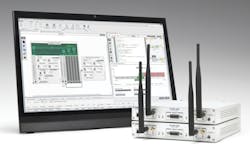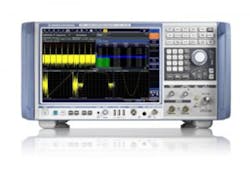Diverse waveforms and frequencies pose challenges
As 5G becomes defined, test-and-measurement companies are working to address the many issues involved, including factors such as frequency, instantaneous bandwidth, modulation scheme, latency, and a smooth evolution from earlier generations of cellular technology. As all these issues are still experimental, engineers will need maximum flexibility as they define the 5G standards and build prototypes while continuing to evolve 4G technology. For the most part, test vendors are leveraging and evolving their existing wireless test products as the road to 5G gets plotted. Several vendors have elaborated on their 5G strategies since EE-Evaluation Engineering’s last special report on the topic.1
Note that the test companies’ 5G strategies are grounded in active participation in 5G initiatives. For example, Andreas Roessler, technology manager, North America, at Rohde & Schwarz, said, “One highlight is the mmMagic project funded by the European Union under the Horizon 2020 objective. In this project, Rohde & Schwarz contributes with its test and measurement expertise to carry out our channel-sounding measurements to better understand the propagation characteristics of frequencies.”
Martha Zemede, 5G and IoT outbound marketing lead at Keysight Technologies, said, “Keysight is an active member in the leading 5G forums and consortia such as H2020, NYU Wireless, 5G Forum, and FutureForum as well as the most influential standards bodies in wireless communications, such as the 3GPP and the Wi-Fi Alliance. In addition, we are collaborating and partnering with key 5G players around the world including network equipment manufacturers, service providers, silicon vendors, and mobile equipment manufactures.”
“Anritsu actively participates in 3GPP RAN groups working on next-generation technologies. We also have representation in some of the public fora involved in helping to define 5G, such as Next Generation Mobile Networks and the Association of Radio Industries and Businesses,” said Mike Barrick, senior business development manager for wireless at Anritsu. “Often, when new technology is being specified, little thought is given to testing until standards are complete. We believe it is essential to be active participants in these groups so testing methodologies are part of the ongoing 5G standard development.”
And finally, Jeffrey Phillips, LabVIEW senior group manager at National Instruments, said, “NI has an active program that works with leading researchers across both industry and academia in the four active vectors of 5G research: massive MIMO, mm-wave, 5G waveforms, and wireless networks/densification.” He cited as one example Nokia Networks, which has demonstrated a fully functional mm-wave prototype that streams data at 10 Gb/s over a 73-GHz wireless link. “A short 18 months after the presentation of the conceptual theory behind the mm-wave development, Nokia is preparing to field test their mm-wave base station in a deployed setting,” Phillips said.
Products take aim at 5G
With regard to specific products, Barrick commented, “Anritsu offers a full portfolio of test capability for wireless devices and infrastructure as well as network-level monitoring solutions,” including the VectorStar ME7838 Series broadband vector network analyzers with mm-wave capability (Figure 1), the MS2830A spectrum analyzer/signal analyzer with high-bandwidth analysis capabilities, and the MP1800A BERT signal quality analyzer, which supports bit-error-rate test from 0.1 Gb/s to 32.1 Gb/s (or 56 Gb/s with an external MUX/deMUX). “While no products have been introduced specifically for 5G due to lack of standards, incremental features have been added to these products over the past six months to aid in early 5G research,” he said.
Courtesy of Anritsu
“Speaking to the lack of 5G standards,” Barrick continued, “the first 3GPP standard that will include 5G is expected to be Release 14 or 15, which is scheduled for 2017 or 2018.” Although that release is still a few years away, he said, Anritsu assumes 5G will include some or all of the following concepts:
- mm-wave operation for high-bandwidth/high-speed applications,
- operation in cellular bands for machine-type communications/Internet of Things (MTC/IoT),
- massive MIMO to enable interference avoidance with hierarchical cells,
- higher-order MIMO and carrier aggregation to enable GB/s over-the-air data rates,
- cloud RAN architecture, and
- OFDM or newer modulations with increased bandwidth over current 20-MHz implementations.
Keysight offers several products for 5G wireless test. According to Zemede, “Keysight has introduced hardware and software solutions to help researchers with the many waveforms, frequencies, and bandwidths being investigated for 5G” (Figure 2).
Courtesy of Keysight Technologies
First, she said, the company offers the Flexible Testbed for 5G Waveform Generation and Analysis, which enables engineers to evaluate the various proposed waveforms with prototype algorithms and hardware. The solution, she said, helps generate and analyze new algorithms and supports a range of modulation bandwidths (from several megahertz to a few gigahertz) and a range of frequency bands (from RF to mm-wave).
The solution employs both hardware and software elements, Zemede said. On the software side, for signal creation, SystemVue software can simulate 5G candidate waveforms, and Signal Studio can create custom FBMC, I/Q, and OFDM waveforms. For demodulation and analysis, she said, “89600 VSA software can be used inside the SystemVue simulation software and can run on a signal analyzer, an oscilloscope, or a PC controlling a variety of instruments or digitizers.”
On the hardware side, she said, a precision AWG and a vector signal generator combination with wideband I/Q inputs enables generation of wideband test signals with up to 2 GHz of modulation bandwidth at frequencies up to 44 GHz (and up to 90 GHz with upconverters). “For signal demodulation and analysis,” she added, “Keysight introduced a 2-GHz-wide smart mixer (M1971E) that can be used with the UXA signal analyzer and oscilloscope to demodulate a 2-GHz-wide signal at frequencies up to 90 GHz.”
Zemede then raised an additional issue. “In any wireless communication architecture, the radio channel has a tremendous effect on system performance so channel models are key in any wireless communication system,” she said. “This will be especially true in 5G with the use of mm-wave carrier frequencies and the lack of experience with radio-access technologies in the mm-wave bands.”
To address this issue, she said, Keysight offers a flexible mm-wave channel-sounding reference solution based on commercial off-the-shelf hardware and software plus additional tools and software used to accelerate analysis of potential 5G channels with real-time data processing and streaming to RAID.
“The reference solution produces a channel impulse response measurement that is used to extract channel parameters for development of new channel models,” she said. “The included calibrations, timing, and synchronization tools also ensure accurate channel measurements. New channel models can be simulated in the SystemVue electronic system-level software to validate new 5G air-interfaces.” In summary, she concluded, the channel-sounding reference solution allows researchers to measure the mm-wave radio channel and extract the key characteristics to develop a dependable model that can be used in simulation and emulation.
Software-defined radio
According to Phillips at National Instruments, “As 5G research continues to unfold, the primary challenge that needs to be solved today is proving out the innovations that will enable the next wave of enhanced bandwidth, reduced latency, and higher signal reliability.” To that end, he said, NI offers several products for 5G wireless test, including an integrated software-defined-radio (SDR) platform that combines flexible software with modular hardware (Figure 3).
Courtesy of National Instruments
“At the heart of the SDR platform is the LabVIEW Communications System Design Suite, a version of LabVIEW designed specifically for communication system design,” he said. “The NI USRP RIO, an FPGA-based SDR, combines LabVIEW Communications System Design Suite graphical programming with high-performance hardware to dramatically simplify development. It offers an ideal combination of flexibility and performance for applications ranging from simple protocol development to 5G wireless communication research.”
Unique Wi-Fi and LTE IP, he said, allows an evolved design flow to streamline the translation of an idea to an FPGA while an intuitive graphical interface supports hardware resource visualization and partitioning—thereby aiding the specific task of prototyping wireless systems.
Rohde & Schwarz offers several products for 5G-5th generation mobile networks test. Roessler said, “One highlight is expanding the analysis bandwidth of the R&S FSW high-end signal and spectrum analyzer family to 2 GHz.” That performance is available when the FSW (Figure 4) is combined with the R&S FSW-B2000 option and an R&S RTO oscilloscope, allowing developers to analyze broadband signals for 5G next-generation mobile communications signals or complex pulse parameters and chirp signals for radar systems. Roessler added, “The R&S FSW itself has been extended to support frequencies up to 85 GHz in a single instrument.”
For signal generation, he added, the R&S SMW vector signal generator now supports frequencies up to 40 GHz—a specification that can be extended with the help of external mixers. In addition, an integrated 2-GHz I/Q capability enables the SMW to modulate up to 2-GHz-wide signals provided by an external arbitrary waveform generator. “On top of extending the frequency range, Rohde & Schwarz added a new measurement option that supports signal analysis of 802.11ad signals,” he added. “802.11ad often is mentioned during 5G discussions since it is the only wireless standard that already utilizes wider bandwidths up to 2.16 GHz and operates in the 60-GHz frequency band.”
Roessler added this observation: “The terms Internet of Things and 5G often are used in the same sentence. To test the IoT, Rohde & Schwarz has developed an over-the-top test solution based on its R&S CMW500 wideband radio communication tester. The application establishes a link to the device under test (for example, via LTE), monitors the signaling messages triggered by an application running on the device, and correlates that with the power consumed by the device. This enables a network operator to analyze device behavior and understand the impact of a certain application to the overall device performance. In terms of IoT, this ensures that the device is optimized for its task, doesn’t create unnecessary frequent network access, and has acceptable power consumption while in operation.”
Building on 4G
The road to 5G begins with earlier standards. Phillips at NI said, “NI has been working with scientists and engineers for years to solve some of the difficult engineering challenges of our time. NI’s platform-based design approach enables engineers to build systems quickly and reuse their software in the future as project requirements change or expand. NI’s 5G prototyping platform takes full advantage of this approach, and researchers who have adopted it are benefiting now by seeing real and impactful results.”
LabVIEW Communications, he said, forms the core of this platform approach, offering a new design flow including floating-point to fixed-point conversion to speed the development of new real-time signal-processing algorithms. “LabVIEW Communications also features complete application frameworks for LTE and 802.11 that enable researchers to start with 4G and then build 5G,” he said. “The application frameworks are scalable, modifiable, and complete to enable researchers to prototype their 5G concepts in real-world environments in a real, working system.”
Keysight’s Zemede said, “Keysight recently introduced a phase-coherent PXIe multichannel vector signal analyzer and generator that can be configured as two, four, or eight-time or phase-synchronized channels. This solution addresses today’s test challenges of LTE/LTE-A MIMO and beamforming, allowing engineers to generate and analyze true MIMO signals.” The same reference solution, she said, can be used for implementing 8×8 MIMO and beamforming for sub-6-GHz 5G research.
In addition, she said, Keysight has recently introduced the capability to upgrade the frequency range of existing X-Series signal analyzers, allowing users to buy what they need today—for example, sub-6-GHz capability for 4G test—and upgrade to microwave or mm-wave frequencies to meet their new requirements as they move to 5G.
As did Roessler at Rohde & Schwarz, Zemede also mentioned the IoT, saying, “We also have added software enhancements to our LTE/LTE-Advanced signal generation and analysis solutions to support 3GPP Release 12 LTE-MTC targeting the IoT segment, which is one of the focus areas of 5G, and we are going to continue to update our software as the 3GPP standard evolves to Release 13 and beyond.”
Reference
Nelson, R., “Test to play key role in 5G rollout,” EE-Evaluation Engineering, February 2015, p. 12.
